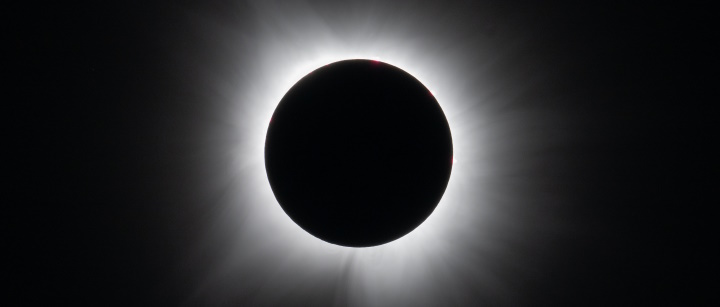Posts Misrepresent Views of Eclipse With Composite Images
Este artículo estará disponible en español en El Tiempo Latino.
Quick Take
During the April 8 eclipse, people in the path of totality were able to see solar phenomena, including the sun’s corona. But social media posts have shared altered or composite images of these phenomena, claiming one image was “captured by NASA.” It was actually an artist’s rendering of a composite photo of the 2017 eclipse.
Full Story
A total solar eclipse — in which the moon blocked Earth’s view of the sun — occurred April 8 in a narrow path across Mexico, the United States and Canada. Crowds gathered in cities along the path, including Dallas, Cleveland and Montreal, to witness totality, the brief period in which the sun’s light is completely obscured by the moon.
In addition to the sky darkening, those in the path of totality were able to see a part of the sun’s atmosphere, called the corona, which is otherwise impossible to see because of the sun’s bright light.
 An actual photo provided by NASA shows the total solar eclipse seen in Dallas on April 8. Photo by NASA/Keegan Barber.
An actual photo provided by NASA shows the total solar eclipse seen in Dallas on April 8. Photo by NASA/Keegan Barber.
Gary Bernstein, a professor of astronomy and astrophysics at the University of Pennsylvania, explained the appearance of the corona in an email to us. “The sun is always in the process of ejecting a tenuous stream of gas into space. This gas emits a very faint light compared to the sun’s main body, so while it’s always present in the sky, we can’t see it on a normal day because it’s lost in the glare of the disk of the sun,” he said.
“During a total eclipse, the moon blocks the disk, and the sky becomes dark enough to see the corona. This only occurs during the totality phase,” Bernstein said.
Another phenomenon known as Baily’s Beads — beads of light that appear around the edge of the moon during an eclipse — occurs just as totality begins and ends. “They occur because the moon has mountains and valleys, and the last rays of the sun can pass through the valleys while the mountains block light. This breaks up the very thin final arc of light into pieces,” Bernstein explained.
NASA uploaded a photo album of pictures taken during the recent eclipse, many of which show Baily’s Beads and the sun’s corona.
But some social media posts have shared the painting of a composite image or an altered image of these phenomena, and misleadingly claimed they were photos of the recent eclipse.
A Digital Painting of a 2017 Composite Photo
One image, featuring a dramatic corona, was shared on Facebook on April 9 with the caption, “Most Detailed Image of the Solar Eclipse.” The post received 88,000 likes, but has since been removed.
Several other posts also shared the image on social media, falsely claiming it was a photo taken during the eclipse and “captured by NASA.” Through a reverse image search, we found this image is actually a digital painting from 2020 by artist Cathrin Machin.
As she wrote in an Instagram caption on July 20, 2020, Machin based her painting on a picture created by astrophotographer Sebastian Voltmer in Wyoming during the 2017 total solar eclipse. Voltmer uploaded his original photo to Flickr in September 2017, and he wrote that the photo was a composite of 35 images taken during the eclipse.
Bernstein explained that many astrophotographers use composite images — that is, an image produced by combining two or more photos — “since we are taking pictures of things the human eye can’t see.” He added: “They’re not what your eye would see but they are ‘real’ in the sense of being an image of what’s truly in the sky.”
Alexei Filippenko, a professor of astronomy at the University of California, Berkeley, told us, “Cameras are good at capturing the solar corona, but only with composites made from images having many different exposures. A given exposure doesn’t have a large ‘dynamic range’ the way the human eye does. The human eye can see faint and bright things well simultaneously, but a photo cannot.”
Image ‘Appears to be Altered’
Another image, which shows both Baily’s Beads and the corona, was posted to Facebook on April 10 with a caption misleadingly claiming it was from the recent eclipse. The caption, originally in Spanish, claims that the photo is “one of the best shots of the solar eclipse.”
But a spokesperson for scientists at the National Solar Observatory told us that “this image appears to be altered.”
“The S-shape of the coronal streamers on the left and right of the corona is the most obvious problem,” the NSO spokesperson told us in an email. “The coronal magnetic field does not bend in such sinuous curves. They are angled and curved at times, but a 90-degree bend in the field lines is unrealistic.”
Filippenko also raised concerns about the waviness of the corona in this image. “Although it could in principle look curvy… I’ve never seen it that way. Always, or almost always, the coronal streamers basically go radially outward from the Sun; they don’t curve much.”
The NSO spokesperson also noted that the placement of the Baily’s Beads in this image were unlikely. “They appear all around the sun simultaneously, which is unrealistic except in a very special eclipse (when the moon was exactly the same size as the Sun, so a very brief eclipse). Also, when the Baily’s beads are still present, the corona is not yet so visible and prominent.”
But during the April 8 eclipse, the moon actually appeared significantly larger than the sun, Filippenko said.
Filippenko also told us the image in the April 10 Facebook post could be a composite photo of several previous eclipses, but not of the April 8 eclipse or any single eclipse.